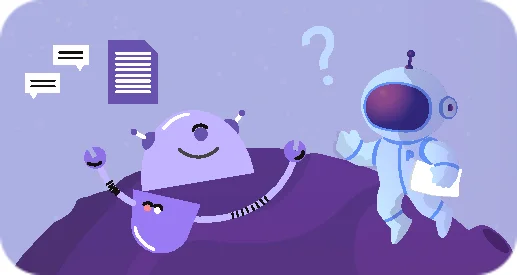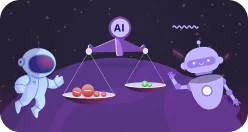I must admit, I envy young people starting college this year. Of course, your high school experience was messed up by the pandemic, but so many incredible things are emerging before your eyes, opening endless possibilities. Take AI-powered tools, for example. When I was a student, AI and IoT were merely annoying buzzwords. A never-ending hype, promising that sci-fi-worthy solutions for everyday life are just around the corner – but never actually there.
Everything was “smart” back then: water bottles, flower pots, jackets, and even jewelry. All you had to do was stick a battery-operated timer with a black-and-white LCD screen on top of a thing, and you could call it “smart” because it supposedly used to “tell you” when it was time for a refill or something equally useless.
Now, however, AI and machine learning have started delivering, and the results make your auntie E want to exclaim, “What a time to be alive!” quite unironically, which rarely happens to Millennials, believe you me. This is why I’m genuinely excited to present you with this list of 10 AI tools you must try as a student, whether a freshman or a senior.
ChatGPT
Of course, the viral sensation won’t substitute the assistance of a professional paper writing service, but it can help with generating ideas for an essay, outlining, and summarizing. It can also dramatically shorten the time you spend on preliminary research. For example, you can ask it what opinions exist on a particular topic and what the main arguments of different camps are. ChatGPT will fill you in on decades of debates and resulting scientific consensus in minutes. You can work on your own arguments from there. However, make sure to fact-check the information you are given since ChatGPT has been known to invent facts, books, events, and even people sometimes.
ChatGPT is currently free, but you need to sign up if you want to save a history of your queries. Despite all its flaws, ChatGPT is so far the fullest embodiment of AI’s promise to education: personalized tutoring, quick responses, and 24/7 access to learning – the features highlighted by AI expert David Karandish in his piece for THE journal.
Grammarly
You probably heard about Grammarly, but I still must put it on this list because it’s an essential writing tool. I like it because it recognizes misspelled words from context. Unlike most spellcheckers built into word processors, Grammarly will point out if you have typed “rite” instead of “right,” “form” instead of “from,” or “though” instead of “thought.”
Grammarly has free and Premium subscriptions. The free plan gives you access to essential grammar, spelling, and punctuation features, while the Premium allows for more nuanced suggestions concerning style, sensitivity, word use, etc.
Speechify
This AI-powered text-to-speech tool works with online articles, emails, PDFs, and other document formats. This is a great aid for students struggling to keep up with their reading for classes. You can just listen to all the class materials or recommended literature while commuting, doing house chores, or exercising. Students who have difficulty reading due to conditions like dyslexia or impaired vision will also appreciate Speecify: unlike many other text-to-speech tools, it supports note-taking and highlighting, which is crucial for productive studying sessions.
It has several voice options and a free version that you can upgrade to Premium for more advanced features.
Anki
Anki is an AI-powered flashcard app that supports spaced repetition, enhances the productivity of your revision sessions – and helps retain knowledge better! Anki is not the first of its kind, but it’s free and unlimited in most of its incarnations: Anki Desktop, AnkiWeb, and AnkiDroid (by other developers). AnkiMobile is an iOS version that is a paid companion to a free MacOS version.
Initially developed for language learning, it became popular for all subjects and especially appreciated by medical students. You can download decks already created for this topic by developers and other users or create your own unique decks.
Dall-E 2
Another of OpenAI’s creations on this list, Dall-E 2 is an AI system that creates realistic images from your text descriptions. As a student, you will need to create presentations for classes a lot. I remember how finding high-quality pictures for slides was such a hassle. Everything that fit my vision was either in poor resolution, copyrighted, or watermarked. Ugh. Likely, you don’t have to do that, living in the future. You just tell AI what you need and choose among the several generated options. One of the other possible applications for Dall-E 2 is visualizing your design ideas for products, video games, interfaces, etc. – depending on what you study.
Dall-E is paid, but it gives you 50 free credits when you sign up, which should be enough to get an idea of how useful this tool is for your personal use.
Krisp
Krisp is an AI-powered meeting assistant with voice clarity technology. It increases the productivity of online meetings by removing background noises, echoes, and other interferences. Moreover, it creates transcription of a discussion with a speech-to-text feature, takes automated notes, and has enhanced security features to protect your privacy. This app is equally helpful if you are a remote student, working from home, or collaborating with others on group projects. It works with Zoom, Teams, RingCentral, Adobe Connect, and other popular conference apps.
All this is free, with the possibility to upgrade to the Pro version. However, the free version is more than enough for personal use and doesn’t require card details to subscribe.
Podcastle
College is the time to explore your passions, learn, and network – and starting your own podcast is a great way to do all of the above. No wonder the podcasting world is so youthful – the average age of podcast users is 12 to 34.
Podcastle is a recording and broadcasting app with AI-powered editing features to ensure studio quality even for your on-the-go recordings. Cleaning up background noises, creating transcripts, and other advanced editing features are automated and easy to apply. Start exploring your passion – or sharing your knowledge on a favorite subject with this free web-based app.
StepWise Math
The app helps you solve math problems, prep for tests and exams, improve at algebra, calculus, and geometry by building critical math skills, or simply brush up on math again. The app uses AI to adapt complexity to match your pace and style of learning. By using short quizzes it assesses areas where you need help or more working on, so you only review what you need.
StepWise Math has a student subscription plan but offers a free trial.
Duolingo
This language-learning app is not news, and you probably know about it already, but it’s just so good I must recommend it again. First of all, it’s one of the most successful examples of gamification in education done right. It does feel like a casual game: achievements, badges, points, rewards, leveling-up, competition, leagues, skins – the whole shebang. Second, it’s free with an option of a Premium subscription, but you don’t have to go Premium in order to learn efficiently. Last but not least is, of course, the AI features.
Duolingo was one of the first language-learning apps to employ machine learning for a flexible and personalized learning experience that accommodates your pace and focuses on your particular areas of improvement. Now, keeping up with the times, Duolingo uses GPT-4 technology to power its teaching techniques.
SciSpace Copilot
This is your personal AI research assistant that helps to parse massive amounts of reading in minutes. Just like ChatGPT, it uses cutting-edge natural language processing algorithms. However, unlike ChatGPT, which is a jack of all trades, SciSpace specializes in scientific publications. It uses innovative search methods to find relevant information and sources for you. Moreover, it can explain complex passages, math, tables, or diagrams in simpler terms.
SciSpace Copilot is free; you don’t even have to sign up to try it. I wish I had something like this while working on my thesis – looking for relevant stuff in my university library was a nightmare! I tell you guys, I envy you!
And all this is just the beginning! AI only starts entering classrooms as educators open the doors tentatively with trembling hands. Abhinand Chincholi, a member of the Forbes Technology Council and CEO of OneOrigin Inc., lists the lack of knowledge about AI in the education sector and uncertainty about the role of teachers as one of the primary challenges AI adoption has to overcome.
For students, AI has the potential to finally make studying even things you aren’t particularly interested in enjoyable. AI also promises to save your instructors time and effort, which can then be better applied for a personalized approach to teaching and respecting each student’s pace and unique strengths. That’s certainly something I’m excited to witness in my lifetime.










